 Here is my view of the Dismal Swamp Canal. It was actually pretty.
Here is my view of the Dismal Swamp Canal. It was actually pretty.I really wasn't too sure what to expect the ICW would look like. I had viewed our route on Google Earth months before our trip started. But even from that vantage point I couldn't tell what it would be like. It was very different from what I expected (and there are many, many different sections all up and down the east coast). The first part was very open, wide and resort like. The homes were scattered through forested shoreline. The area was very stunning in the early morning sunlight.
We initially started our ICW voyage under sail alone. But as the waterway started to narrow and change direction and the wind slowly fell off we decided to start the motor. We continued on under motor and sail. As the waterway began to narrow further and the current started to increase we came upon a dredge busy deepening the channel.
 Dredgeing the channel is a full time operation.
Dredgeing the channel is a full time operation.
We initially started our ICW voyage under sail alone. But as the waterway started to narrow and change direction and the wind slowly fell off we decided to start the motor. We continued on under motor and sail. As the waterway began to narrow further and the current started to increase we came upon a dredge busy deepening the channel.
 Dredgeing the channel is a full time operation.
Dredgeing the channel is a full time operation.There were several small work boats chugging about, moving pipe and supporting the operation. Steve contacted the dredge, communicated our intention and direction and we moved on past. However, just after we cleared the dredge our motor sputtered and came to a stop, out of gas. I moved forward and retrieved the gas can. Steve filled the gas tank and attempted to start the motor. It wouldn't start. We waited a few moments and tried again with no success. Five minutes passed and still no power. We were now drifting towards the shore and one of the work boats. There was traffic from other boats moving in both directions. As a rookie, I was thinking I should be getting out the paddle just in case. Steve just sat patiently and with the shore and drifting tree limbs fast approaching, he gave the engine starter cord a tug and the motor sprang to life. Ok, that was fun. We motored on.
We had been having some flooding trouble with the motor earlier. It seemed if we completely refilled the gas tank we would experience the flooding problem, so we only did partial fills. It seemed to help, some. We tried to work out our position for refueling carefully so as to avoid another mid-channel incident. We could go about two hours on a tank of gas. The flooding problem didn't happen each refueling, but we were prepared just in case. After several hours of very pleasant cruising, we knew we needed to refuel one last time and then put in at a marina to fill up the gas can for the remainder of the trip into Beaufort. Steve had a marina identified on his chart. When the motor started to sputter, out of gas, we refueled, and to avoid the dreaded flooding syndrome we only put in enough gas to reach the marina. Steve kept an eye out as we neared the location indicated on the chart.
 I'm sure it's just around the next bend.
I'm sure it's just around the next bend.
Now we had the main sail flopping loosely in the light breeze with the jib and mizzen doing all the work along with the motor. Everything seemed to be working out perfectly as the marina appeared ahead. Steve scanned the marina with his binoculars and discovered it was more a repair and storage yard and had no fuel station. Bummer.
The next marina was miles on down the waterway. So on we went. Half an hour later we saw the marina and it was a full service one! It looked like we were going to just putt putt in and tie up. Wrong. We ran out of gas about 200 yards away. Fire drill time. I got the gas can, Steve filled the motor's gas tank, pulled the cord and the flooding problem reared its ugly head once again. This time we were in the middle of the channel, the current moving smartly and lots of other traffic. We were fast approaching the marina and could not afford to pass it as it was the last fueling opportunity until Beaufort. At what seemed like the last minute, Steve quickly tightened the main. Spartina picked up speed in the light breeze and current and sprang forward. Steve then pushed the tiller hard over and we shot into the marina. He slacked the main and jib and we just glided up to the slip. I tossed our line up to the dock hand and we came to a stop. I was totally impressed as were several onlookers standing on the dock. It looked like we knew what we were doing. Yes we meant to do that!
We completed the rest of the journey to Beaufort without further incident. We didn't experience the flooding problem again for the remainder of the trip. Up until that part of our trip we had been in open water and had plenty of room to manuver. The narrow channels of the ICW posed some interesting challenges for us. As we are preparing for our next trip this May, I can't help but wonder what lies in store for us. That is what I like about outdoor adventures, anything can happen. How you handle yourself can make all the difference. With Steve as the skipper, I'm not worried about how we will fare.
Bruce
We had been having some flooding trouble with the motor earlier. It seemed if we completely refilled the gas tank we would experience the flooding problem, so we only did partial fills. It seemed to help, some. We tried to work out our position for refueling carefully so as to avoid another mid-channel incident. We could go about two hours on a tank of gas. The flooding problem didn't happen each refueling, but we were prepared just in case. After several hours of very pleasant cruising, we knew we needed to refuel one last time and then put in at a marina to fill up the gas can for the remainder of the trip into Beaufort. Steve had a marina identified on his chart. When the motor started to sputter, out of gas, we refueled, and to avoid the dreaded flooding syndrome we only put in enough gas to reach the marina. Steve kept an eye out as we neared the location indicated on the chart.
 I'm sure it's just around the next bend.
I'm sure it's just around the next bend.Now we had the main sail flopping loosely in the light breeze with the jib and mizzen doing all the work along with the motor. Everything seemed to be working out perfectly as the marina appeared ahead. Steve scanned the marina with his binoculars and discovered it was more a repair and storage yard and had no fuel station. Bummer.
The next marina was miles on down the waterway. So on we went. Half an hour later we saw the marina and it was a full service one! It looked like we were going to just putt putt in and tie up. Wrong. We ran out of gas about 200 yards away. Fire drill time. I got the gas can, Steve filled the motor's gas tank, pulled the cord and the flooding problem reared its ugly head once again. This time we were in the middle of the channel, the current moving smartly and lots of other traffic. We were fast approaching the marina and could not afford to pass it as it was the last fueling opportunity until Beaufort. At what seemed like the last minute, Steve quickly tightened the main. Spartina picked up speed in the light breeze and current and sprang forward. Steve then pushed the tiller hard over and we shot into the marina. He slacked the main and jib and we just glided up to the slip. I tossed our line up to the dock hand and we came to a stop. I was totally impressed as were several onlookers standing on the dock. It looked like we knew what we were doing. Yes we meant to do that!
We completed the rest of the journey to Beaufort without further incident. We didn't experience the flooding problem again for the remainder of the trip. Up until that part of our trip we had been in open water and had plenty of room to manuver. The narrow channels of the ICW posed some interesting challenges for us. As we are preparing for our next trip this May, I can't help but wonder what lies in store for us. That is what I like about outdoor adventures, anything can happen. How you handle yourself can make all the difference. With Steve as the skipper, I'm not worried about how we will fare.
Bruce










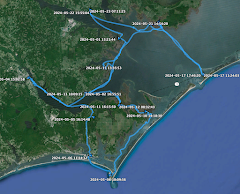
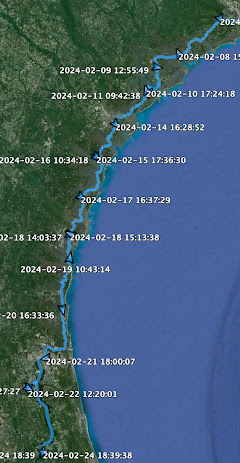

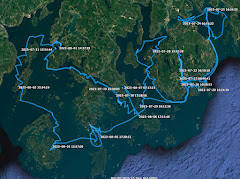

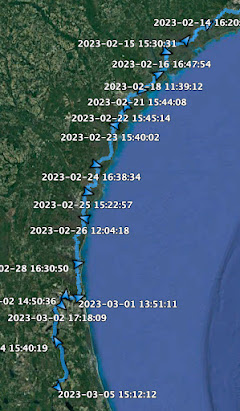


























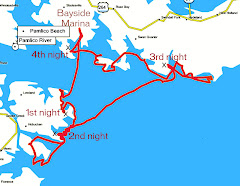


1 comment:
I've since learned that the key to to running an outboard is the use of fuel stabilizer. Outdoors writer Angus Phillips of the Washington Post wrote a nice piece on this topic. Apparently gas that contains ethanol, which I guess about all the gas we can buy does, tends to break down over time. The result is water in the gas supply. The trick, I have learned from Angus, is to add stabilizer at the gas pump. I did that this past year and and great luck with the outboard. Another lesson learned!
Post a Comment